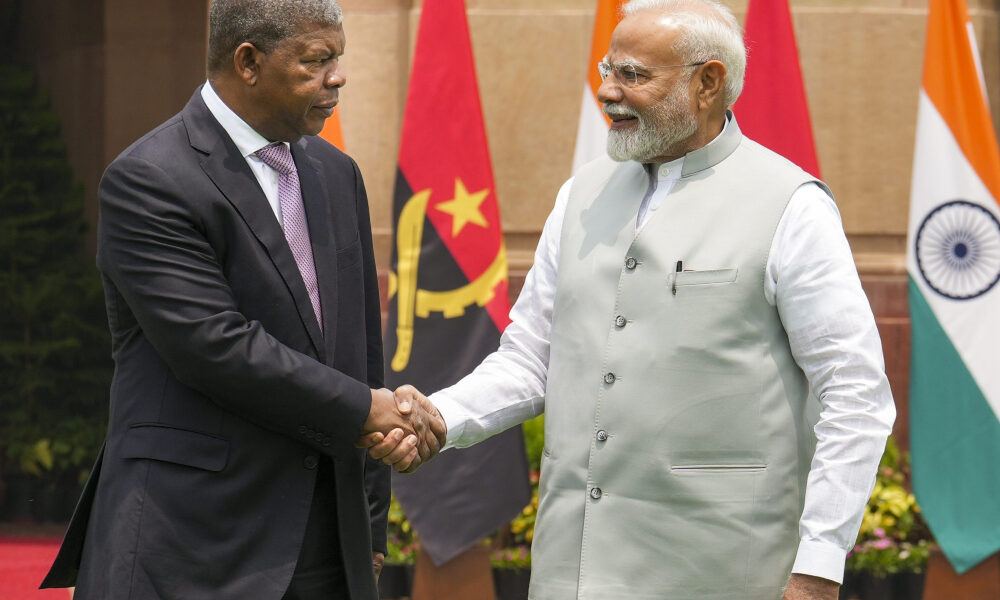
- A key takeaway from the visit was India’s announcement of a US$200 million Line of Credit to modernise Angola’s armed forces, covering upgrades to Russian-built Su-30s, new acquisitions, training, and institutional development, marking a shift from transactional defence deals to a long-term, equal security partnership.
- In the civilian and development sphere, three MoUs were signed on agriculture, youth exchange, and pharmaceuticals, covering tractors, irrigation, millet farming, and healthcare, including Ayurvedic and modern medicine, with plans for increased Indian personnel and local recruitment; notably, Angola already hosts the largest share of Indian professionals in the region.
- In the area of Energy and Sustainability, Angola joined the International Solar Alliance (ISA) to advance its solar energy ambitions, while India’s Digital Public Infrastructure was highlighted as a model for enhancing Angola’s digital governance, financial inclusion, and public service delivery.
From May 1-4, 2025, the President of Angola, João Manuel Gonçalves Lourenço, made a historic state visit to India, the first visit of an Angolan President in more than 40 years. The visit was held on the occasion of the 40th anniversary of the establishment of the two countries’ diplomatic relations, which was marked by a renewal of the commitment to strengthen relations in a wide range of fields.
Strengthening Bilateral Relations
One of the key takeaways from the visit was the announcement of India’s US$ 200 million Line of Credit (LoC) to facilitate the modernisation of Angola’s armed forces. This includes modernising and retrofitting existing military equipment, which includes Russian-built Su-30 fighter jets, and purchasing new equipment, training and institutional capacity development measures. This move also represents a departure from transactional defence procurement to a longer-term security partnership of equals.
On the Economic and Trade Engagement front, India’s trade with Angola has witnessed a gradual increase and crossed $4.19 billion during the fiscal year 2023–24. Oil is still a cornerstone of this exchange, but both countries have made it clear that they have every intention to extend co-operation across the board. Pacts were also inked on diamond processing, fertiliser manufacturing, and trade of strategic minerals, a move aimed at diversifying and ramping up economic links.
Regarding the Civilian and Development Cooperation, three MoUs were agreed upon on agricultural development, youth exchange and pharmaceutical cooperation. These projects will cover tractors and irrigation, experimental millet farming and improved healthcare, including making Indian Ayurvedic and modern medicine. “More people from India will come as well, local staff would be recruited” Angola, too, has the largest share of Indian professionals right now.
On Energy and Sustainability, Angola officially became a new member of the International Solar Alliance (ISA) to develop solar energy. India’s Digital Public Infrastructure framework was cited as a prototype model that had the potential to shape Angola’s digital governance, financial inclusion and service delivery mechanisms.
As an indicator of Multilateral Cooperation, the Chair of the African Union, President Lourenço and Prime Minister Narendra Modi decided to synchronise schedules and themes with a view to priorities to be tackled at the 4th India-Africa Forum Summit, in an affirmation of their common desire to foster multilateral collaboration.
Significance of the Visit
The visit is a manifestation of the shared desire for enhanced economic cooperation and a changed approach to India-Angola relations. President Lourenço sent a message of admiration and friendship, citing the prospects for increased business opportunities. Prime Minister Modi reiterated India’s rapidly expanding and deepening strategic and economic engagement with Africa, stating that the leadership of Angola in the African Union was central to furthering the collective aspirations of the Global South.
Looking ahead, with both countries setting their sights on working with one another in the future, the question is what new ambitious benchmarks will the burgeoning relationship reach next? The visit laid the foundation for a stronger and more diversified strategic partnership based on historical and mutual aspirations.
References:
- Angola–India relations. (2025, May 7). Wikipedia. https://en.wikipedia.org/wiki/Angola%E2%80%93India_relations
- Angola signs the International Solar Alliance agreement during President Lourenço’s visit. (2025, May 4). The Tribune India. https://www.tribuneindia.com/news/world/angola-signs-international-solar-alliance-agreement-during-president-lourencos-india-visit/
- Angola, India strengthen renewable energy partnership at business forum. (2025, May 4). Techpression. https://techpression.com/angola-india-strengthen-renewable-energy-partnership-at-business-forum/
- India and Angola Strengthen Bilateral Ties with Expanded Energy, Defence, and Economic Cooperation. (2025, May 5). Energy Capital & Power. https://energycapitalpower.com/india-and-angola-strengthen-bilateral-ties-with-expanded-energy-defense-and-economic-cooperation-eq/
- India and Angola decide to expand their energy partnership. (2025, May 4). Economic Times. https://energy.economictimes.indiatimes.com/news/renewable/india-angola-decide-to-expand-energy-partnership/120867532
- India Extends $200M Credit Line to Angola During Lourenco’s State Visit. (2025, May 3). GBC News. https://gbc1.net/index.php/2025/05/03/india-extends-200m-credit-line-to-angola-during-lourencos-state-visit/
- India-Angola Ties Enter New Strategic Era as President Lourenço Visits New Delhi. (2025, May 7). The Habarinetwork. https://www.thehabarinetwork.com/india-angola-ties-enter-new-strategic-era-as-president-lourenco-visits-new-delhi
Shashank is a Master’s student in Diplomacy, Law, and Business at O.P. Jindal Global University. He is also a researcher and coordinator at the Center for Global South and the Center for Southeast Asian Studies. His research interests include Southeast Asia, Chinese foreign policy, India’s Act East Policy, and global security dynamics. Views expressed are the author’s own.
